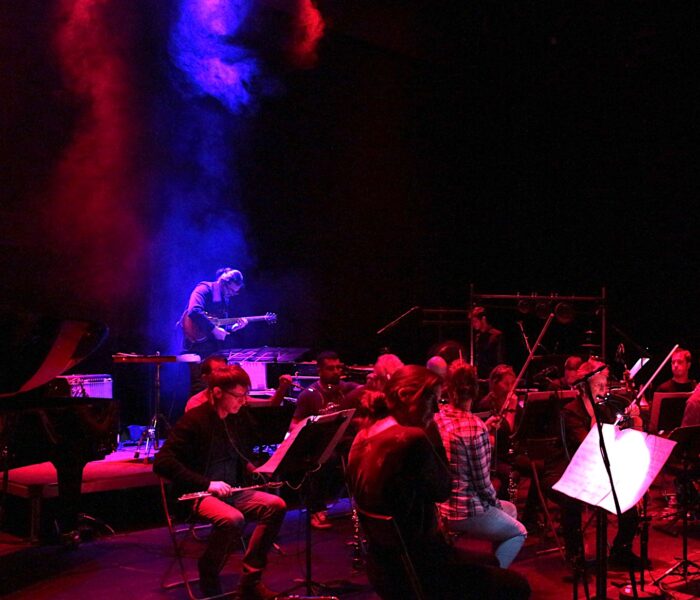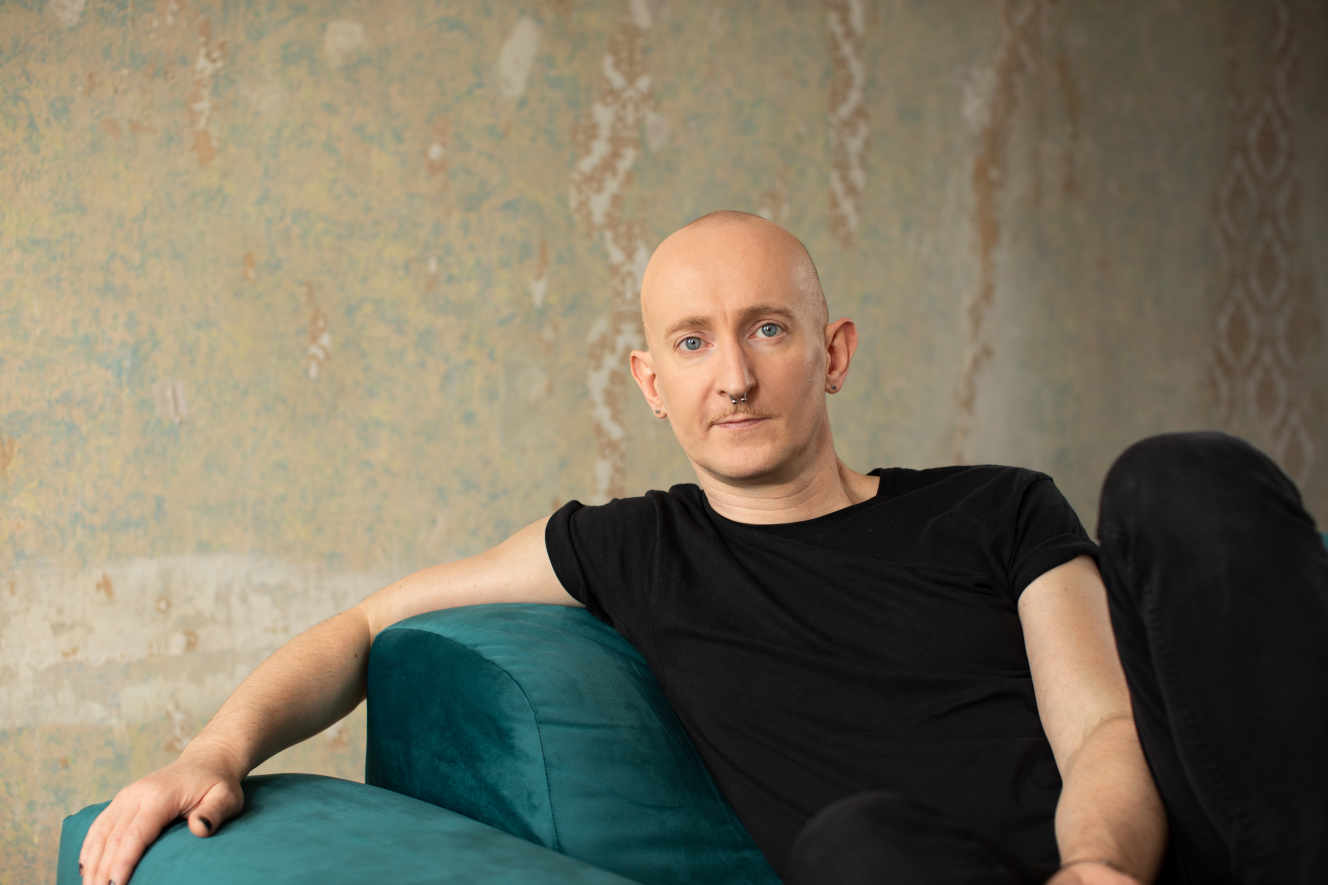La compositrice suédoise Malin Bång inaugure le printemps avec une riche actualité : d’un côté, la pièce pour instruments et objets Inuti, créée le 24 mars à Strasbourg par l’ensemble lovemusic dans le cadre de Botanica, et diffusée la même semaine sur France Musique, de l’autre la musique de scène Judith’s Gaze – I, volcanic sur un livret de Mara Lee Gerden – le pendant contemporain du Château de Barbe-Bleue de Béla Bartok – qu’elle présentera le 19 avril au Folkoperan de Stockholm.
Une occasion rêvée pour rencontrer cette compositrice solaire, à la sérénité contagieuse.
Malin, tu es venue en France pour participer à la création de ta pièce Inuti par le collectif lovemusic, quelle est ta relation à la France et à la scène de musique contemporaine française ?
J’ai vécu un an à Paris il y a longtemps, en 1996. C’était une parenthèse dans mes études de musique. Je voulais vivre autre chose. C’est un très beau souvenir : je prenais quelques cours de français, j’allais au concert, j’assistais à des séminaires sur la composition au CNSMdP… À cette époque, j’y ai suivi un cours de Gérard Grisey, même si personnellement je n’ai pas d’affinités avec la musique spectrale.
J’ai aussi participé à l’Académie Voix Nouvelles de Royaumont. C’était une expérience précieuse car j’ai pu rencontrer beaucoup de compositeurs français. Ensuite, je suis revenue en France pour une résidence de composition à la Cité des Arts en 2010. Toute occasion de venir passer un moment à Paris me réjouit toujours!
En dehors de lovemusic, est-ce que tu as eu d’autres collaborations avec des ensembles français dans le passé ?
Il y a quelques années, j’ai eu la chance de travailler avec l’Ensemble 2e2m. A Royaumont, pendant l’académie, ma musique a été jouée par l’ensemble Cairn.
Par ailleurs, à l’époque de mes études de composition, j’avais aussi pris part à l’Académie d’été de l’Ensemble Aleph : c’était une expérience très inspirante. J’avais rencontré à cette occasion beaucoup de jeunes compositeurs d’un peu partout.
Avant de créer Inuti pour France musique, lovemusic avait joué deux de tes pièces, je crois ?
Oui, mais je n’avais pas pu assister aux concerts. Cette fois, on a fait connaissance. J’aime beaucoup l’esprit de ce collectif, car il est très proche finalement de celui du groupe que j’ai créé à Stockholm, en Suède : les Curious Chamber Players. Les deux collectifs ont la même façon de choisir les musiques, la même curiosité, la même volonté d’expérimenter, d’embrasser les styles de musique les plus divers. Autre point commun, le fait d’être un groupe d’amis, réunis par le plaisir de créer ensemble, avec aussi cette joie, ce bonheur de partager des choses simples de la vie quotidienne : un repas par exemple !
La seule différence est que Curious Chamber Players est un ensemble dirigé. C’est mon mari Rei Munakata qui dirige l’ensemble. Il est aussi compositeur et joue des objets, au gré des configurations.
Depuis quand existe cet ensemble ?
L’ensemble est né en 2003. Nous venions tous et toutes de terminer nos études au conservatoire. Nous avions déjà des projets en cours et nous voulions avoir une structure pour les faire vivre. L’idée est venue de proposer à tous nos amis musiciens de nous rejoindre dans cet ensemble. Le groupe est né comme ça. Bien entendu, l’ensemble a vécu quelques transformations dans sa composition à cause de certains changements de vie – nous étions jeunes – mais aujourd’hui nous sommes un ensemble très soudé, animé par une même passion pour la création. On s’apporte beaucoup mutuellement.
Vous êtes plusieurs compositeurs au sein de l’ensemble ?
Il y a Rei et moi, mais on collabore avec beaucoup d’autres compositeurs.
Tu joues d’un instrument dans ce groupe ?
Parfois, je joue des objets acoustiques. J’ai commencé la musique enfant par le piano et le violon, puis l’alto, mais très vite, dans la composition; je recherchais des sons qu’on ne trouve pas sur les instruments de musique traditionnels ; j’avais envie d’enrichir ma palette sonore. Donc j’ai commencé à introduire des objets, et le plus commode était que je les joue moi-même ! C’est comme ça que j’ai commencé à manipuler des objets sur scène.
Le désir de composer ta propre musique s’est concrétisé à partir de quel moment ?
L’envie d’écrire ma propre musique est venue assez tôt, et progressivement. Je me souviens avoir ressenti le désir de jouer du piano quand j’avais six ans. J’ai dit à mes parents : “il nous faut un piano”. Ils ont donc trouvé un piano…
Ensuite, il y a eu les cours de musique à l’école. Très vite j’ai pensé que la musique était ce que je voulais faire dans la vie, même si je ne savais pas encore quelle forme cela prendrait.
J’aimais jouer du piano. j’étais attirée par les musiques de timbres, la musique pour piano de Debussy par exemple. Un peu plus tard, je suis allée spontanément vers des musiques plus contemporaines. A l’école, avec des amis, on aimait organiser des performances qui associaient la musique et le théâtre. Je crois que la joie de créer est née de ces performances. Plus tard, à l’adolescence, je me suis ouverte à différents styles de musique de scène : les jams, l’opéra, la comédie musicale… J’étais très impressionnée par toutes ces approches de la musique, et j’avais très envie d’aller dans cette direction, mais pour cela, je devais d’abord apprendre la composition ! J’ai commencé à composer de façon plus consciente au lycée. En fait, à partir de l’âge de seize ans, je n’ai pas cessé d’écrire de la musique.
Tu disais manipuler des objets sur scène. En effet, tu introduis souvent des objets dans l’effectif instrumental et scénique. Tu aimes les sons bruités, soufflés, frottés. La friction me semble être une caractéristique de ta musique…
La façon dont j’organise mes matériaux sonores est souvent reliée à la présence ou à l’absence d’une friction, et le spectre est large : ça peut aller de l’air qui sort de nos lèvres (pas de friction dans de tels sons), à des sons qui contiennent beaucoup de friction et nécessitent beaucoup de force physique. Ce sont des énergies très différentes.
J’ai le même type de relation aux hauteurs de sons. Quand on doit chanter une note aiguë par exemple, cela demande beaucoup d’énergie, de friction, a contrario d’un jeu sur le souffle, pianissimo.
Est-ce que cela veut dire que tu penses d’abord la musique en termes de friction et de mouvement ? Quel rôle joue le binôme tension-détente dans les musiques que tu imagines ?
L’un n’empêche pas l’autre. J’aime aussi la relation classique de tension et de détente à l’intérieur d’une œuvre, mais je la déplace, car ce ne sont pas les hauteurs de son qui m’intéressent. Pendant mes études, j’ai essayé d’imaginer des progressions harmoniques qui amenaient ce type de tension, mais en réalité je me suis aperçue que je n’écoute pas du tout la musique de cette façon. J’ai vécu comme une libération le fait d’utiliser les sons pour eux-mêmes, et pour leur mouvement physique : je m’intéresse à la façon dont le son évolue, et comment je peux suggérer ce mouvement dans ma musique.
Souvent, je suis à la recherche de sonorités qui ont des qualités “élastiques”, qui peuvent apparaître pianissimo et en arrière-plan d’abord, pour se développer et contenir beaucoup d’énergie au moment voulu.
Dans beaucoup de tes œuvres, tu utilises la voix, le souffle des instrumentistes.
Le recours à la voix des musiciens s’est développé avec les années, à cause de la physicalité des sons instrumentaux et des objets que j’ajoute, et aussi pour obtenir une relation entre le corps du musicien et son instrument. De fait, le souffle s’est introduit naturellement dans le jeu, et aussi la voix, comme pour soutenir le son instrumental.
Inuti est une œuvre qui sollicite justement la voix des musiciens, leur souffle, et aussi la manipulation d’objets. C’est une pièce tactile, sensorielle qui semble correspondre à la nécessité de revenir à quelques fondamentaux ?
En effet ! L’idée centrale de cette pièce est la mise en relation de notre corps avec le monde extérieur par le contact, les sens. C’est un chemin entre le dedans de nos corps et le dehors du monde. C’est une forme de manifeste, une façon d’exprimer ma frustration face à l’importance du numérique, à ces plateformes de plus en plus commerciales qui font intrusion dans nos vies et détournent notre attention, dès qu’on ouvre une page sur le web. On a beau tous être conscients du danger, on se laisse happer !
Avec cette composition, j’ai essayé de me concentrer sur nos expériences sensorielles : ce qui se passe quand on touche la surface d’une boîte en bois, d’un instrument de musique… Ou ce qui se produit dans notre bouche quand on joue d’un instrument à vent, quand on essaie de dire quelque-chose, alors qu’on a la bouche fermée… Comment on éprouve le contact d’une brindille sur la peau, la main, la joue…
Je crois que j’avais besoin de cela aussi dans mon évolution personnelle. J’ai voulu ouvrir un espace différent, plus intérieur, éloigné de la rumeur et de l’agitation de la toile.
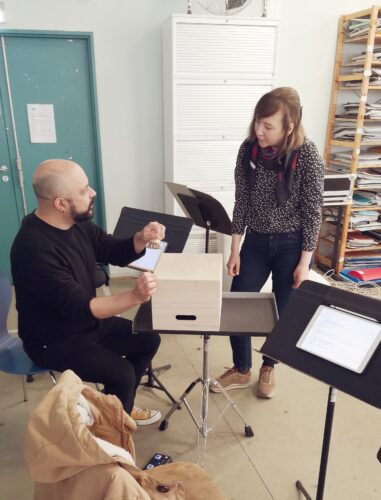

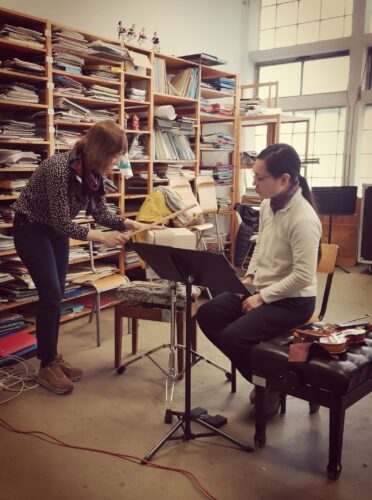
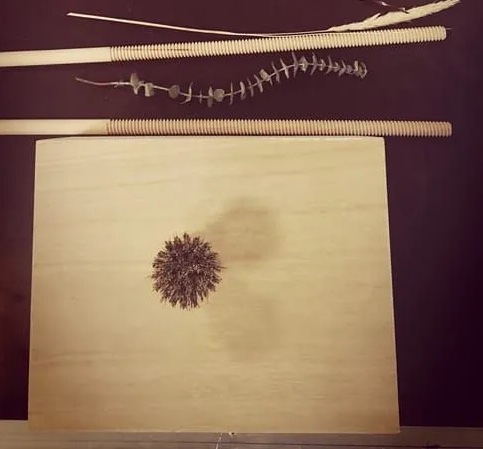
La nature, les végétaux apparaissent souvent d’une façon ou d’une autre dans ta musique. Dans Inuti par exemple, les musiciens doivent manipuler des brindilles de saule, d’eucalyptus, de roseau…
Mon intérêt pour la nature a beaucoup grandi ces dernières années. J’ai lu beaucoup de livres sur la vie des plantes, sur la façon dont elles communiquent notamment. Il existe beaucoup d’ouvrages sur ce sujet, et c’est passionnant. En 2015-16, j’ai écrit Kutzu, une pièce qui porte le nom d’une plante grimpante d’Asie. Dans cette composition, j’ai voulu explorer les relations existantes entre les plantes et les humains dans le contexte du changement climatique. Le fait est que les plantes ont une grande faculté d’adaptation. Elles communiquent si bien aussi ! Elles ont même une forme de solidarité : on dit que certaines plantes viennent au secours d’autres plantes. Finalement, le monde végétal est beaucoup plus résistant que les humains… Au fil de ces lectures, j’ai appris à toujours plus respecter les plantes ! Et puisqu’on parle aujourd’hui beaucoup du changement climatique, on pourrait tirer quelques enseignements de la résistance du monde végétal : sur sa façon de fonctionner, de s’adapter, de communiquer et de durer. Ces questions-là ont pris de plus en plus d’importance pour moi.
Dans Inuti, tu dénonces le poids du numérique et l’importance que les plateformes ont pris dans nos vies quotidiennes. Dans ta page d’orchestre de 2015, splinters of ebullient rebellion, tu t’intéressais au fait qu’un individu isolé pouvait contribuer à des changements de société, grâce aux réseaux sociaux. Ces questions-là semblent t’occuper beaucoup ?
La composition peut être un journal dans lequel on écrit ce qui se passe dans la vie de tous les jours, ce qui nous préoccupe. Quand j’ai composé cette page d’orchestre, le contexte était très différent de celui d’aujourd’hui. Je n’avais pas encore cette vision négative du monde numérique.
À cette époque, les plateformes numériques permettaient réellement aux gens de manifester leur désaccord, de se mobiliser pour une cause. C’était un outil de discussion politique. Certains changements de société pouvaient se faire via la voix des citoyens. Il suffisait que quelqu’un s’exprime, et c’était comme une étincelle qui allumait des réactions en chaîne partout dans le monde. Ces initiatives courageuses en faveur de plus de liberté sont fondamentales !
Cette pièce d’orchestre a pour thème central justement la relation entre l’individu et le collectif. Le collectif est symbolisé ici par l’orchestre. Vu du dehors, l’orchestre est une structure très hiérarchisée, mais vu du dedans, il est constitué de l’addition d’individus avec leurs convictions propres. La combinaison de ces deux situations m’intéresse beaucoup !
Donc dans cette page splinters of ebullient rebellion, certains musiciens s’expriment parfois de façon personnelle. D’autres fois, ils sont la voix de l’autorité. J’ai voulu jouer sur cette ambivalence des rôles.
La relation entre l’individu et le collectif, tu l’expérimentes à travers ta double activité : d’un côté la composition – pratique plutôt solitaire -, de l’autre la vie collective comme co-directrice artistique d’un ensemble. Comment trouves-tu l’équilibre entre ces deux pôles ?
C’est très important de trouver l’équilibre entre les deux ! L’équilibre peut varier du tout au tout selon les périodes de la vie. Pendant quelques années, au moment où je me consacrais à la composition et aux concerts avec les Curious Chamber Players, j’arrivais à trouver cet équilibre, mais à partir du moment où j’ai commencé à composer de longues pièces pour orchestre, les choses se sont déséquilibrées, car c’est un travail sur le long terme. J’ai dû passer quantité d’heures à la table, ce que j’apprécie énormément aussi, mais au bout d’un moment, malgré soi on est coupé du monde ! C’est pourquoi dans ces moments-là, le contact avec mes étudiants a été salutaire : mon activité de pédagogue m’a permis de retrouver cet équilibre entre le monde intérieur et le monde extérieur.
Propos recueillis par Anne Montaron
À voir le 19 avril au Folkoperan de Stockholm, Judith’s Gaze – I, volcanic
À écouter : Inuti sur France Musique
Photos © lovemusic



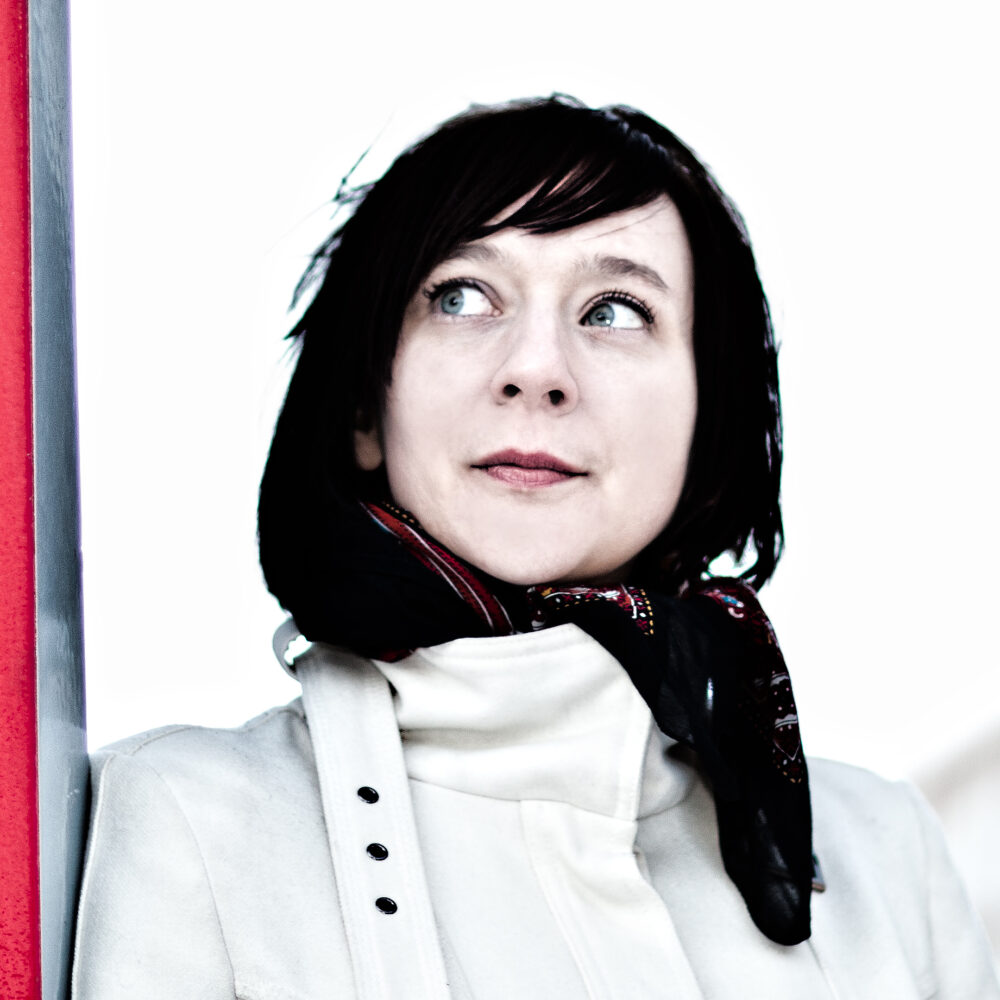)

